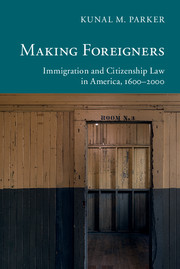Book contents
- Frontmatter
- Contents
- Preface and Acknowledgments
- 1 Introduction
- 2 Foreigners and Borders in British North America
- 3 Logics of Revolution
- 4 Blacks, Indians, and Other Aliens in Antebellum America
- 5 The Rise of the Federal Immigration Order
- 6 Closing the Gates in the Early Twentieth Century
- 7 A Rights Revolution?
- 8 Conclusion and Coda
- Bibliographic Essay
- Index
6 - Closing the Gates in the Early Twentieth Century
Published online by Cambridge University Press: 05 September 2015
- Frontmatter
- Contents
- Preface and Acknowledgments
- 1 Introduction
- 2 Foreigners and Borders in British North America
- 3 Logics of Revolution
- 4 Blacks, Indians, and Other Aliens in Antebellum America
- 5 The Rise of the Federal Immigration Order
- 6 Closing the Gates in the Early Twentieth Century
- 7 A Rights Revolution?
- 8 Conclusion and Coda
- Bibliographic Essay
- Index
Summary
Introduction
Almost 13 million immigrants entered the United States between 1900 and 1914, a number greater than the number that had entered over the previous three decades, a period twice as long. The sheer volume of early-twentieth-century immigration could not escape attention. Neither could the changes in its composition. On the eve of World War I, Southern and Eastern European countries outranked Northern and Western European ones as major sending countries. On the West Coast, there were smaller streams of immigrants from Asian countries, including Japan, Korea, India, and the Philippines. In the West and Southwest, there was a growing influx of Mexicans. Early-twentieth-century immigration was also inextricably intertwined with each of the massive and wrenching changes – industrialization, urbanization, capital–labor strife, imperialism, and entanglement in foreign affairs – that transformed the United States after 1900.
In light of immigration's scale, diversity, and significance in the early twentieth century, it is not surprising that Americans developed strong reactions to it. Concerns about race and national origin had always been part of immigration discourses. What is noteworthy in the early twentieth century, however, is the “scientific” cast that such discourses acquired. Between 1890 and 1920, prominent social scientists, many with prestigious university appointments, endorsed immigration restriction on the ground that native-born Americans were being drowned in a sea of racial inferiors. Their focus was heavily on Eastern and Southern European immigration. Madison Grant's influential eugenicist text, The Passing of the Great Race; or the Racial Basis of European History (1916), identified three European races – the Alpine, the Mediterranean, and the Nordic – that varied “intellectually and morally just as they do physically.” Authentic native-born Americans were Nordics, described as “a race of soldiers, sailors, adventurers and explorers, but above all, of rulers, organizers and aristocrats.” Unfortunately, according to Grant, Nordics were not reproducing in sufficient numbers and, to make matters worse, were annihilating themselves in internecine conflicts such as World War I. Ranged against this noble, enterprising, and tragically diminishing native stock were throngs of Southern and Eastern Europeans, Asians, and Mexicans pouring into the country. These were, as the social scientist Edward Ross described Eastern Europeans, “the beaten members of beaten breeds.”
- Type
- Chapter
- Information
- Making ForeignersImmigration and Citizenship Law in America, 1600–2000, pp. 148 - 184Publisher: Cambridge University PressPrint publication year: 2015

